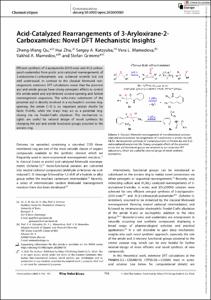Qu, Zheng-Wang; Zhu, Hui; Katsyuba, Sergey; Mamedova, Vera L.; Mamedov, Vakhid A.; Grimme, Stefan: Acid-Catalyzed Rearrangements of 3-Aryloxirane-2-Carboxamides: Novel DFT Mechanistic Insights. In: ChemistryOpen. 2020, vol. 9, iss. 7, 743-747.
Online-Ausgabe in bonndoc: https://hdl.handle.net/20.500.11811/10549
Online-Ausgabe in bonndoc: https://hdl.handle.net/20.500.11811/10549
@article{handle:20.500.11811/10549,
author = {{Zheng-Wang Qu} and {Hui Zhu} and {Sergey Katsyuba} and {Vera L. Mamedova} and {Vakhid A. Mamedov} and {Stefan Grimme}},
title = {Acid-Catalyzed Rearrangements of 3-Aryloxirane-2-Carboxamides: Novel DFT Mechanistic Insights},
publisher = {John Wiley & Sons},
year = 2020,
month = jul,
journal = {ChemistryOpen},
volume = 2020, vol. 9,
number = iss. 7,
pages = 743--747,
note = {Efficient synthesis of 3-arylquinolin-2(1H)-ones and N-(2-carboxyaryl)-oxalamides from protic acid-catalyzed rearrangements of 3-aryloxirane-2-carboxamides was achieved recently but not well understood. In contrast to the classical Meinwald rearrangement, extensive DFT calculations reveal that the proximal aryl and amide groups have strong synergetic effects to control the amide-aided and aryl-directed oxirane-opening and further rearrangement sequences. The ortho-nitro substituent of the proximal aryl is directly involved in a nucleophilic oxirane ring-opening, the amide C=O is an important proton shuttle for facile H-shifts, while the N-aryl may act as a potential ring-closing site via Friedel-Crafts alkylation. The mechanistic insights are useful for rational design of novel synthesis by changing the aryl and amide functional groups proximal to the oxirane ring.},
url = {https://hdl.handle.net/20.500.11811/10549}
}
author = {{Zheng-Wang Qu} and {Hui Zhu} and {Sergey Katsyuba} and {Vera L. Mamedova} and {Vakhid A. Mamedov} and {Stefan Grimme}},
title = {Acid-Catalyzed Rearrangements of 3-Aryloxirane-2-Carboxamides: Novel DFT Mechanistic Insights},
publisher = {John Wiley & Sons},
year = 2020,
month = jul,
journal = {ChemistryOpen},
volume = 2020, vol. 9,
number = iss. 7,
pages = 743--747,
note = {Efficient synthesis of 3-arylquinolin-2(1H)-ones and N-(2-carboxyaryl)-oxalamides from protic acid-catalyzed rearrangements of 3-aryloxirane-2-carboxamides was achieved recently but not well understood. In contrast to the classical Meinwald rearrangement, extensive DFT calculations reveal that the proximal aryl and amide groups have strong synergetic effects to control the amide-aided and aryl-directed oxirane-opening and further rearrangement sequences. The ortho-nitro substituent of the proximal aryl is directly involved in a nucleophilic oxirane ring-opening, the amide C=O is an important proton shuttle for facile H-shifts, while the N-aryl may act as a potential ring-closing site via Friedel-Crafts alkylation. The mechanistic insights are useful for rational design of novel synthesis by changing the aryl and amide functional groups proximal to the oxirane ring.},
url = {https://hdl.handle.net/20.500.11811/10549}
}






